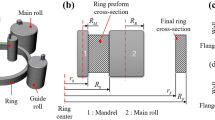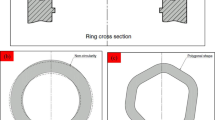Abstract
Ring rolling is a hot forming process used in the production of railway tyres, anti friction bearing races and different ring shaped work pieces for automotive energy production and aerospace applications. The advantages of ring rolling process include short production time, uniform quality, closed tolerances, good material quality and considerable saving in material cost. Despite the benefits some problems still exist according to a correct selection of the process parameters. Due to the nature of the process different rolling mills (driving, idle and axial rolls) are involved and the correct selection of the process parameters is not so feasible. Moreover an experimental approach to solve this problem risks to be more expensive. Actually FE codes are available to simulate the non linear problem that characterizes a ring rolling process. In this work a FE model, based on Deform 3D software, was tested versus experimental results acquired from an industrial plant. The accuracy of the FE model was analyzed through a dual comparison: by geometrical and by physical aspects. A good agreement was found between experimental and numerical results for both comparisons and, as a consequence, this code could be used in order to investigate and optimize the process parameters that characterize the ring rolling process in a virtual not expensive environment. The validated model will allow the studies of more environment-friend process configurations.












Similar content being viewed by others
References
Shivpuri R, Eruc E (1995) Int J Mach Tools Manufact 32:379–398
Johnson W, Mamalis AG (1979) Int Metals Rev 24:137–148
Johnson W, Needham G (1968) Int J Mech Sci 10:95–113
Johnson W, Macleod I, Needham G (1968) Int J Mech Sci 10:455–468
Mamalis AG, Johnson W, Hawkyard JB (1976) J Mech Eng Sci 18:184–195
Utsunomiya H, Saito Y, Shinoda T, Takasu I (2002) J Mater Process Technol 125–126:613–618
Feng-Lin Y, Lin H, Yong-Qiao W (2007) Int J Mach Tool Manufact 47:1695–1701
Allwood JM, Kopp R, Michels D, Music O, Öztop M, Stanistreet TF, Tekkaya AE (2005) CIRP Ann 54:233–236
Li CS, Liu XH, Wang GD (2007) J Mater Process Tech 183:425–431
Chen JS, Roque C, Pan C, Button ST (1998) J Mater Process Tech 80:642–646
Chen JS, Wang HP (2000) Comput Methods Appl Mech Eng 187:441–468
Ryoo JS, Yang DY, Johnson W (1985) Adv Tech Plast 2:1292–1298
Logura CF, Bramley AN (1987) Int J Mech Sci 29:149–157
Sawamiphakdi K, Pauskar PM, Jin DQ, Lahoti GD (2002) Proceedings of 7th ICTP, 1: 28–31
Yang H, Wang M, Guo LG, Sun ZC (2008) Comput Mater Sci 44:611–621
Lim T, Pillinger I, Hartley P (1998) J Mater Process Tech 80–81:199–205
Yea Y, Ko Y, Kim N, Lee J (2003) J Mater Process Technol 140:478–486
Song JL, Dowson AL, Jacobs MH, Brooks J, Beden I (2002) J Mater Process Tech 121:332–340
Wang M, Yang H, Sun ZC, Guo LG (2009) J Mater Process Tech 209:3384–3395
Sun Z, Yang H, Ou X (2008) Trans Nonferrous Met Soc China 18:1216–1222
Davey K, Ward MJ (2002) J Mater Process Tech 125–126:619–625
Davis JR (1996) ASM specialty handbook—carbon and alloy steels
Author information
Authors and Affiliations
Corresponding author
Rights and permissions
About this article
Cite this article
Giorleo, L., Giardini, C. & Ceretti, E. Validation of hot ring rolling industrial process 3D simulation. Int J Mater Form 6, 145–152 (2013). https://doi.org/10.1007/s12289-011-1056-5
Received:
Accepted:
Published:
Issue Date:
DOI: https://doi.org/10.1007/s12289-011-1056-5




